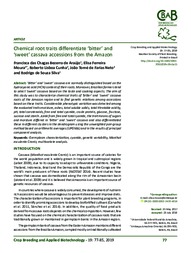Chemical root traits differentiate 'bitter' and 'sweet' cassava accessions from the Amazon.
Chemical root traits differentiate 'bitter' and 'sweet' cassava accessions from the Amazon.
Author(s): ARAÚJO, F. das C. B. de; CUNHA, E. F. M.; CUNHA, R. L.; FARIAS NETO, J. T. de; SILVA, R. de S.
Summary: 'Bitter' and 'sweet' cassava are normally distinguished based on the hydrocyanic acid (HCN) content of their roots. Moreover, Brazilian farmers tend to select 'sweet' cassava based on the taste and cooking aspects. The aim of this study was to characterize chemical traits of 'bitter' and 'sweet' cassava roots of the Amazon region and to find genetic relations among accessions based on these traits. Considerable phenotypic variation was detected among the evaluated traits moisture, ashes, total soluble solids, total titratable acidity, pH, total carotenoids, free and total cyanide, crude protein, glucose, fructose, sucrose and starch. Aside from free and total cyanide, the trait means of sugars and moisture differed in 'bitter' and 'sweet' cassava and also differentiated these in different clusters in the dendrogram using the unweighted pair-group method based on arithmetic averages (UPGMA) and in the results of principal component analysis.
Publication year: 2019
Types of publication: Journal article
Unit: Embrapa Eastern Amazon
Observation
Some of Embrapa's publications are published as ePub files. To read them, use or download one of the following free software options to your computer or mobile device. Android: Google Play Books; IOS: iBooks; Windows and Linux: Calibre.
Access other publications
Access the Agricultural Research Database (BDPA) to consult Embrapa's full library collection and records.
Visit Embrapa Bookstore to purchase books and other publications sold by Embrapa.

